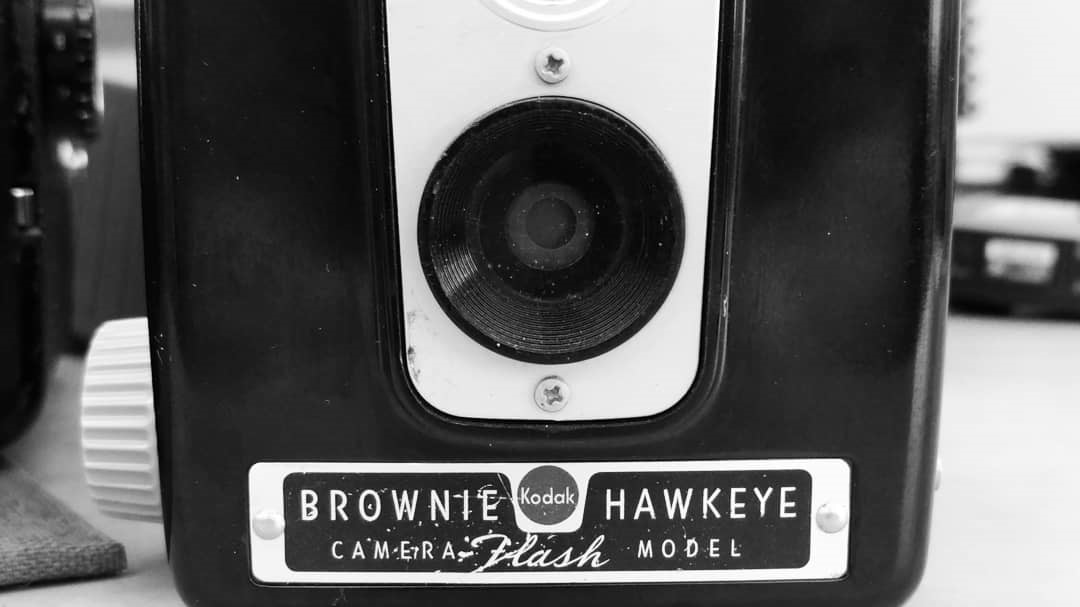Photos, snapshots of a minute frame of time, often only a fraction of a second, provide a stark and seemingly frozen glance into the past. Special Collections Research Center’s (SCRC) exhibit through April, From Tintypes to .TIFFs displays a variety of these tiny glimpses into the past in a multitude of different formats. Tintypes, cyanotypes, salt paper prints, Polaroid’s, 35mm negatives, and large format silver gelatin blow ups decorate our exhibit cases further studded with examples of photographic equipment from the art form’s beginnings to the modern era. The cameras alone provide quite the draw for students. Many have forms vaguely recognizable today, others, less so – to the point of seeming more like industrial or scientific equipment than the sleekly portable digital units so common today. The history of photography is itself as storied and complex as any similar scientific development, though often and especially these days, the medium is used far more frivolously.
We take thousands of Snapchats, each disposed of in ten seconds or less, Instagram our meals, and post vacation photos to Facebook for the world to ogle and “like.” Some more cynical critiques of this generation (and technological progress on the whole) decry the instant gratification and immediate disposability of modern photographic culture. “In my day, film had to be developed! You couldn’t ‘retake’ photos you didn’t like on the fly, you had to wait!” My strawman critic of modern culture notwithstanding, there does seem to be something lost in today’s explosion of photographic implements – everything has a camera attached today, most seemingly as an afterthought. Most computers have webcams, all cell phones are armed with sensors that would boggle the minds of 19th century shutterbugs, and now even some fridges have inward facing cameras that can show you whether or not your milk is running low. We’ve been flooded with cameras!
Despite the ubiquity of what was once an extremely expensive and chemically complicated profession, I’d argue that’s what was important at photography’s birth that remains so today. The “how” of photography is not near as important as the “why.” As a historian, the snapshots that are interspersed throughout the display cases outside SCRC provide windows into the past in ways that words, spoken or written, could never convey. They provide us links to all of our senses.
The soldier standing rigidly for the camera in the 1860s comes across as simultaneously proud of his service, and distinctly afraid of his future. His family, likely paying for the memento, might have used this to show off his nobility in service or remember him in death. Today, we get both. The snapshots of a line of gunships in Vietnam or of astronauts on the moon not only portray the ever grinding wheel of human progress, but tickle other senses of their viewers. The down rush of the helicopters whirring blades kicks hot, red earth into our faces; the cold backdrop of stars behind a lunar explorer crushes us with loneliness, and yet still fills us with wonder. Photos are frozen out of time, encompassing all of the emotion of that moment as well as the visual.
Even today’s point-shoot-post style of photography holds meaning – if only for one or two people. So do not disparage those who snap, who Instagram, who shoot and re-shoot selfies, encourage them to continue to connect with others, with their history, and with their world. Because after all, you never know when one of those photos might end up behind display case glass.
From Tintypes to .TIFFs will be up from now until April and we will be having a reception on February 19th from 2-4 with light refreshments and a guest speaker, Dr. Vanessa Schulman. We also have comment cards in our exhibit area for any feedback you may have, good or bad. We would love to hear from you! Stay tuned for updates on our reception, events, or future exhibits.
Follow Special Collections Research Center on Social Media at our Facebook, Instagram, and Twitter accounts. To search the collections held at Special Collections Research Center, go to our website and browse the finding aids by subject or title. You may also e-mail us at speccoll@gmu.edu or call 703-993-2220 if you would like to schedule an appointment, request materials, or if you have questions. Appointments are not necessary to request and view collections.




